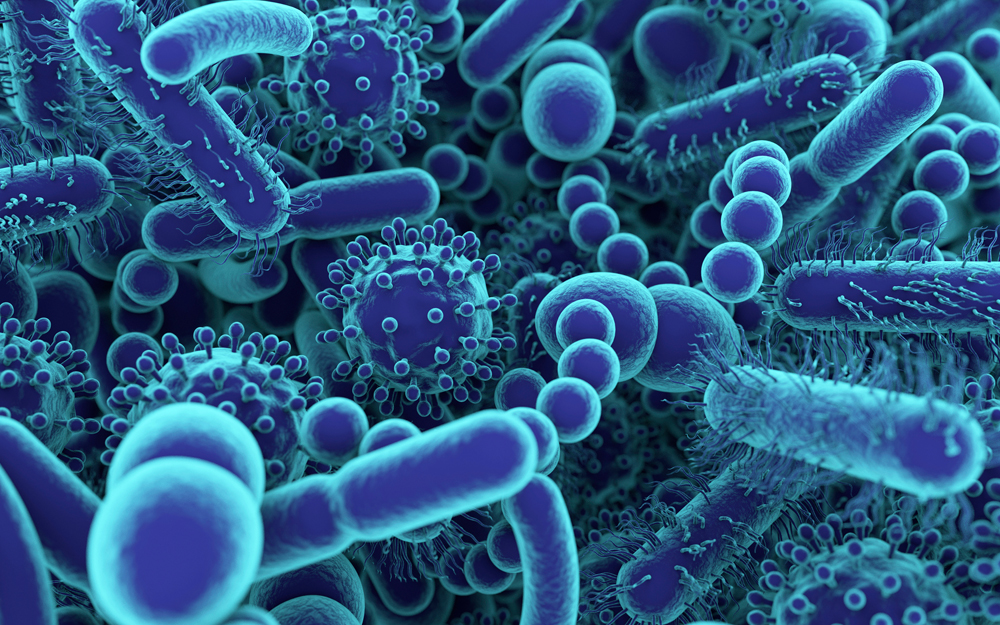Cedars-Sinai Blog
Viruses, Bacteria and Fungi: What’s the Difference?
Sep 25, 2025 Cedars-Sinai Staff

Each of us shares our life with tiny colonies of microorganisms that include viruses, bacteria and fungi. Most of these miniscule microbes are harmless, but some are pathogens—the kind that can make you sick.
What makes a virus, such as the flu or the highly contagious virus that causes COVID-19, different from other germs, such as bacteria or a fungus? How do they each infect us, and how can we recover from them?
Fayyaz Sutterwala, MD, PhD, director of Infectious Diseases at Cedars-Sinai, says infections are sometimes difficult to diagnose. Certain microbes can cause very specific diseases that are easy to diagnose. But many others cause similar symptoms, making it hard to determine what is causing the infection without further tests.
“For example, bacteria, viruses and fungi can all cause slightly different forms of pneumonia,” he says. “The symptoms are subtly different depending on the type of microbe causing the condition. As doctors, we evaluate to determine the best tests and treatments for each infection.”
Below, we explain some differences among these common germs.

Fayyaz S. Sutterwala, MD, PhD
If you’re sick, a healthcare provider can run tests to help determine whether your symptoms are caused by a virus, bacteria or fungi. If your symptoms are not severe, schedule an appointment with your primary care doctor. If your symptoms are severe or are not improving after a few days, seek immediate medical attention at an urgent care facility or emergency room. People who live in California also can use Cedars-Sinai Connect, a mobile app that provides 24/7 access to Cedars-Sinai experts for urgent issues.
Viruses
Viruses cause common ailments such as colds and the flu, as well as more serious conditions such as Ebola, HIV/AIDS and COVID-19.
How Viruses Make Us Sick
A virus is the simplest of germs: It is just genetic material encased in protein. Researchers debate whether a virus is even “alive.”
By itself, a virus can accomplish nothing. It needs to enter a living thing to perform its only function, which is to replicate—or make copies of itself. When a virus gets inside a human body, it can hijack a person’s cellular machinery to produce clones of itself, overtaking more cells as it continues to reproduce.
When the virus reproduces faster than the immune system can control it, it begins to destroy cells and harm the body.
Viruses are the smallest germ, making them generally the easiest to contract—or “catch.” They’re so tiny they can spread through the air in a cough or a sneeze. Some viruses also are spread by mosquitoes or through bodily fluid.
"Bacteria, viruses and fungi can all cause slightly different forms of pneumonia. The symptoms are subtly different depending on the type of microbe causing the conditions. As physicians, we evaluate to determine the best tests and treatments for each infection."
How to Treat Viruses
Doctors may prescribe antiviral medications to treat life-threatening illness, manage chronic infections or shorten how long symptoms last. But for patients who are not at high risk of complications and do not have severe symptoms, doctors may instead recommend they recover at home by resting, drinking plenty of fluids and treating symptoms with over-the-counter medications.
The best defense against viruses is to avoid infection in the first place. Here are some ways to protect yourself:
- Vaccines give preemptive protection by training the body’s immune system to recognize and attack a specific virus, such as the measles.
- Washing your hands with soap and water frequently can help protect you from some viruses, including colds and the flu.
- Bug repellent can help prevent bites from mosquitoes, which can carry the Zika virus and West Nile virus, among others.
Bacteria
Bacteria cause common conditions such as food poisoning, strep throat and urinary tract infections, as well as serious infections such as tuberculosis.
How Bacteria Make Us Sick
Bacteria are bigger and more complex than viruses, though they can still spread through the air. A bacterium is a single cell, and it can live and reproduce almost anywhere, including in soil, in water and in our bodies.
For the most part, we live peacefully with bacteria. For example, the bacterial colonies in our guts are helpful to us and strengthen our immune system. But like viruses, bacteria can also harm us by replicating quickly in our bodies and killing cells. Some bacteria also produce toxins that can kill cells and cause an outsized, damaging immune reaction.
We can “catch” bacterial infections when someone who is sick sneezes near us or when we touch contaminated surfaces, skin and fluids. We can also become sick if we’re bitten by an infected insect or if we consume contaminated food or water.
How to Treat Bacterial Infections
Broad-spectrum antibiotics were developed to kill bacteria in our bodies and in the food supply by inhibiting their growth. But bacteria are extremely adaptive and can quickly evolve to evade antibiotics. Bacteria share their antibiotic-resistant genes with each other, meaning more strains generate resistance to the drugs we use.
This is why for some bacterial infections where there is a low risk of complications and where patients do not have severe symptoms, doctors may recommend patients recover at home by resting, drinking plenty of fluids and managing symptoms with over-the-counter medications. If your doctor does prescribe antibiotics for a bacterial infection, be sure to take all the doses they prescribed, even if you are feeling better.
Here are some ways you can help protect yourself from harmful bacteria:
- Wash your hands frequently with soap and water.
- Vaccines provide protection against some bacterial infections, such as tetanus, whooping cough, diphtheria and pneumonia.
- To help prevent foodborne illness, make sure to wash fruits and vegetables and store and prepare foods according to the instructions on their labels.
- Bug repellent can help prevent bites from ticks and mosquitoes carrying harmful bacteria, such as the bacteria that causes Lyme disease.
Fungi
Fungi are responsible for causing common conditions such as yeast infections and ringworm, as well as serious illnesses such as valley fever.
How Fungi Make Us Sick
Fungi—including yeast and mold—are more complicated organisms than viruses and bacteria. They are eukaryotes, which means they have complex cells. Of the three pathogens—viruses, bacteria and fungi—fungi are most similar to animals in their structure.
There are two main types of fungi:
- Environmental fungi live in soil and don’t generally cause infection in most healthy people.
- Commensal fungi live on and in us and generally don’t hurt us. In fact, they may play a beneficial role in our overall health.
Certain environmental fungi reproduce through spores, and these particles can enter our body through the lungs or by contact with our skin. These fungi can be especially damaging for people with weakened immune systems, as the fungi can spread quickly and damage many organs.
Other fungal infections can be caused by an overgrowth of commensal fungi.
How to Treat Fungal Infections
Fungi are slow to mutate, so they are easier to target with antifungal medications than bacteria are with antibiotics. Speak with a healthcare provider if you suspect you have a fungal infection, as many fungal infections do not get better without treatment. Your doctor may prescribe a topical antifungal medication (such as a cream or ointment) or a pill or IV antifungal medication, depending on whether the infection is on the surface of the skin, hair or nails—or in the body.
Here are some ways to help reduce your risk of a fungal infection:
- Keep your skin clean and dry, especially in areas where sweat and moisture tend to accumulate.
- Wear clothing made from fabrics that allow your skin to breathe.
- Avoid walking barefoot in public showers and near pools.
- Protect your skin, face and eyes from contact with dirt and mold, and wear a respiratory mask in dusty or moldy areas.


